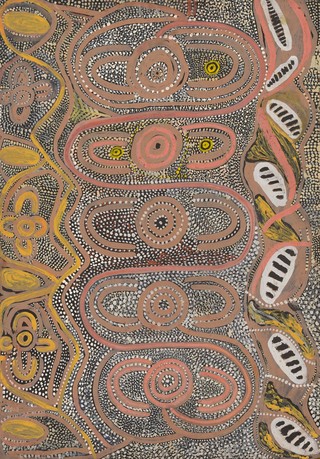Papunya Tula Art Movement boards retained in Australia

Johnny Warangkula Tjupurrula, Luritja people, Australia c.1918–2001 / Women's ceremony in a cave (detail) 1971 / Synthetic polymer powder paint on composition board / 46 x 34cm / Purchased 2021 with the support of the Australian Government through the National Cultural Heritage Account and the QAGOMA Foundation / Collection: Queensland Art Gallery | Gallery of Modern Art / © Estate of Johnny Warangkula Tjupurrula/Licensed by Aboriginal Artists Agency / View full image
QAGOMA has acquired seven Papunya boards with funds from the Australian Government’s National Cultural Heritage Account, painted in the first critical years of Australia’s contemporary Aboriginal art movement.
Watch | Introduction to seven Papunya boards
The Gallery is dedicated to showcasing historical and contemporary Indigenous Australian art and reflecting the rich diversity of Aboriginal and Torres Strait Islander cultures. This acquisition guarantees this important set of paintings are retained in Australia.
Purchased from the Ian Rogers Collection in Melbourne, the seven boards represent the work of the founding artists of the Papunya Tula Art Movement in the Northern Territory, which began in 1971.

Foreground: Doreen Reid Nakamarra, Pintupi/Ngaatjatjarra people WA/NT, Australia c.1955-2009 / Untitled (Marrapinti) 2008 / Synthetic polymer paint on canvas / 213 x 275cm / Purchased 2009 with funds from the Bequest of Grace Davies and Nell Davies through the Queensland Art Gallery Foundation. Collection: Queensland Art Gallery | Gallery of Modern Art / © Doreen Reid Nakamarra / Licensed by Aboriginal Artists Agency Ltd / Background: Central and Western Desert room at Queensland Art Gallery. National Cultural Heritage Funded boards, alongside proposed acquisition of Papunya boards from a Private Collection, and existing QAGOMA works / © The artists / Licensed by Aboriginal Artists Agency Ltd / View full image
The seven Papunya board paintings are:
- Johnny Warangula Tjupurrula Women’s ceremony in a cave 1971 (illustrated)
- Kaapa Mbitjana Tjampitjinpa Untitled (Goanna Story) 1971 (illustrated)
- Mick Namarari Tjapaltjarri ‘Tingari’ Cycle Dreaming Journey 1972 (featured in video)
- Tim Leura Tjapaltjarri Untitled (Euro Dreaming Ceremony) 1972 (illustrated)
- Uta Uta Tjangala Tjitiji Kutjarra at Yawarrankunya (Two Boys Dreaming) 1972
- Tim Leura Tjapaltjarri Bushfire Corroboree 1973 (featured in video)
- Charlie Tarawa (Wartuma) Tjungurrayi The Importance of Fire 1973 (illustrated)
Johnny Warangula Tjupurrula Women’s ceremony in a cave 1971

Johnny Warangkula Tjupurrula, Luritja people, Australia c.1918–2001 / Women's ceremony in a cave 1971 / Synthetic polymer powder paint on composition board / 46 x 34cm / Purchased 2021 with the support of the Australian Government through the National Cultural Heritage Account and the QAGOMA Foundation / Collection: Queensland Art Gallery | Gallery of Modern Art / © Estate of Johnny Warangkula Tjupurrula/Licensed by Aboriginal Artists Agency / View full image
Kaapa Mbitjana Tjampitjinpa Untitled (Goanna Story) 1971

Kaapa Mbitjana Tjampitjinpa, Anmatyerre/Arrernte people, Australia c.1925–89 / Untitled (Goanna Story) 1971 / Synthetic polymer paint on composition board / 78.5 x 54.5cm / Purchased 2020 with the support of the Australian Government through the National Cultural Heritage Account and the QAGOMA Foundation / Collection: Queensland Art Gallery | Gallery of Modern Art / © Estate of Kaapa Mbitjana Tjampitjinpa/Licensed by Aboriginal Artists Agency / View full image
Tim Leura Tjapaltjarri Untitled (Euro Dreaming Ceremony) 1972

Tim Leura Tjapaltjarri, Anmatyerre/Arrernte people, Australia NT c.1929–84 / Untitled (Euro Dreaming Ceremony) 1972 / Synthetic polymer paint on composition board / 61 x 48cm / Purchased 2020 with the support of the Australian Government through the National Cultural Heritage Account and the QAGOMA Foundation / Collection: Queensland Art Gallery | Gallery of Modern Art / © Estate of Tim Leura Tjapaltjarri/Licensed by Aboriginal Artists Agency / View full image
Charlie Tarawa (Wartuma) Tjungurrayi The importance of fire 1973

Charlie Tararu Tjungurrayi, Pintupi people, Australia 1921–99 / The importance of fire 1973 / Synthetic polymer paint on plywood / 42 x 50cm / Purchased 2020 with the support of the Australian Government through the National Cultural Heritage Account and the QAGOMA Foundation / Collection: Queensland Art Gallery | Gallery of Modern Art / © Estate of Charlie Tararu Tjungurrayi/Licensed by Aboriginal Artists Agency / View full image
The acquisition of the Papunya Boards for QAGOMA is supported through the Australian Government’s National Cultural Heritage Account.
The National Cultural Heritage Account helps keep items of cultural significance in Australia so they can be preserved and made available to the public.

